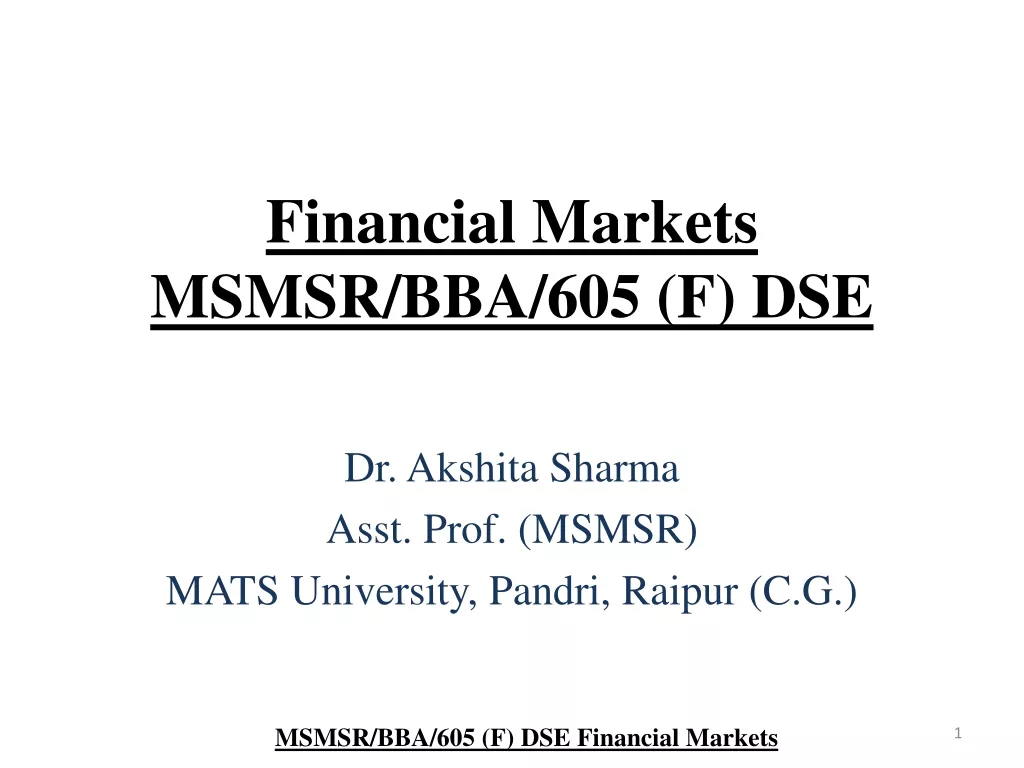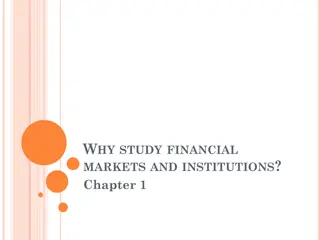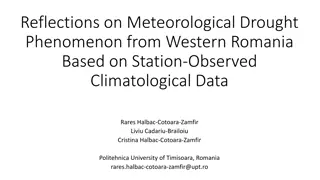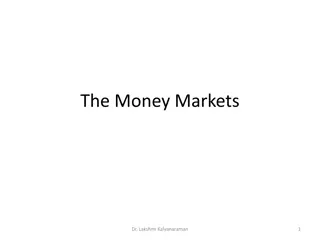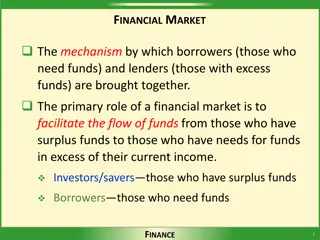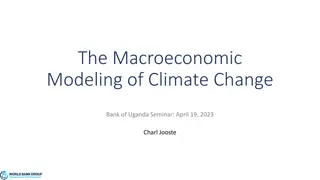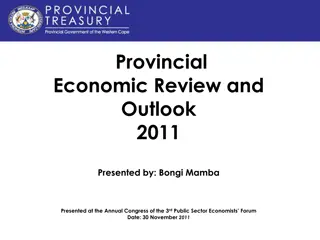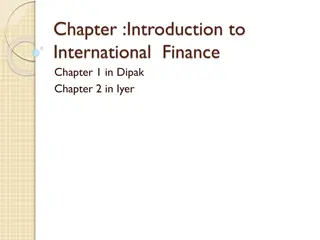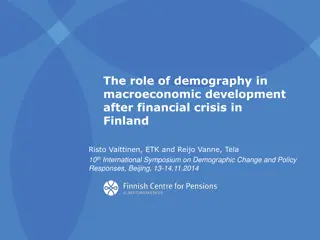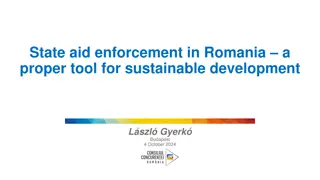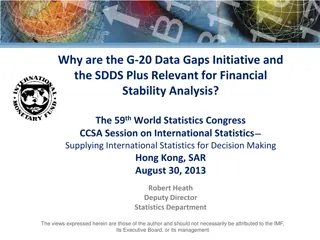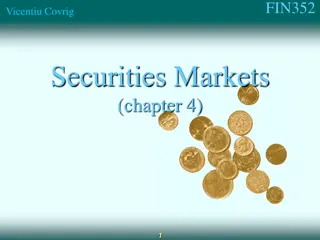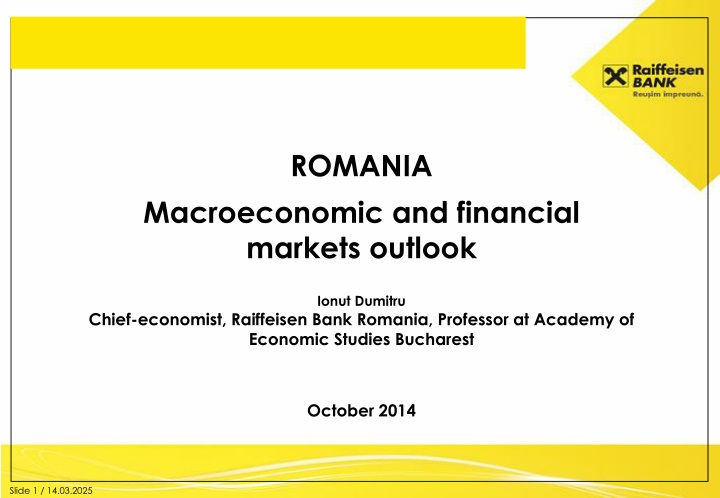
Romania Macroeconomic and Financial Markets Outlook - Major Trends in Economy
Slow economic recovery in Romania post-crisis, with uneven sector performance. Strong exports driving GDP growth but facing macroeconomic imbalances. Analysis by Ionut Dumitru, Chief Economist at Raiffeisen Bank Romania.
Download Presentation

Please find below an Image/Link to download the presentation.
The content on the website is provided AS IS for your information and personal use only. It may not be sold, licensed, or shared on other websites without obtaining consent from the author. If you encounter any issues during the download, it is possible that the publisher has removed the file from their server.
You are allowed to download the files provided on this website for personal or commercial use, subject to the condition that they are used lawfully. All files are the property of their respective owners.
The content on the website is provided AS IS for your information and personal use only. It may not be sold, licensed, or shared on other websites without obtaining consent from the author.
E N D
Presentation Transcript
ROMANIA Macroeconomic and financial markets outlook Ionut Dumitru Chief-economist, Raiffeisen Bank Romania, Professor at Academy of Economic Studies Bucharest October 2014 Slide 1 / 14.03.2025
Part I: Major trends in the economy over the past years Slide 2 / 14.03.2025
Slow economic recovery pace in last years, much below pre-crisis levels Economic activity re-entered on an upward trend in 2011, but pace of economic recovery remained modest over the past years. Economic performance deteriorated over the last quarters as real GDP fell by 0.1% qoq in Q1 and by 0.9% qoq in Q2. Real GDP excluding agriculture (% qoq) Real GDP excluding agriculture (% yoy) 12 1.5 7.3% per year 1.2 9 0.9 6 2.1% per year 0.6 3 0.3 1.5 0 0.0 -0.3 -3 -0.6 -6 -0.9 -9 -1.2 02Q2 03Q2 04Q2 05Q2 06Q2 07Q2 08Q2 09Q2 10Q2 11Q2 12Q2 13Q2 14Q2 -1.5 09Q4 10Q2 11Q2 11Q4 12Q2 12Q4 13Q2 13Q4 14Q2 09Q2 10Q4 Real GDP excluding agriculture (% yoy) Source: Eurostat, National Institute of Statistics, Raiffeisen RESEARCH Slide 3 / 14.03.2025
Economic recovery was uneven across the sectors Exports and industrial sectors relying on exports had a very good performance over the past years, while domestic demand and sectors relying on domestic demand had a poor performance. 150 150 140 140 Exports Exports 130 130 120 120 110 110 GDP excluding agriculture Industry 100 100 GDP excluding agriculture 90 90 Private consumption Private services 80 80 Gross investments (private and public) 70 70 Construction 60 60 08Q2 09Q2 10Q2 11Q2 12Q2 13Q2 14Q2 08Q2 09Q2 10Q2 11Q2 12Q2 13Q2 14Q2 Note: fixed base indexes, H1 2008 = 100 Note: fixed base indexes, H1 2008 = 100 Source: National Institute of Statistics, Raiffeisen RESEARCH Slide 4 / 14.03.2025
Very good performance of exports Exports of goods and services increased quite fast over the past years, being the main driver of GDP growth. Romania outperformed its regional peers in terms of exports since the crisis began in 2008. Good performance of exports resulted in a good performance of industry. Especially exports of automotive industry (motor passenger cars and parts and accessories for transport means) had a good performance. This category of exports almost doubled (+91%) between 2008 and 2013 when they stood at 8.6% of GDP. Exports of goods and services (2008Q1=100) Gross value added in industry (2008Q1=100) 150 140 140 130 130 120 120 110 110 100 100 90 90 80 80 70 70 08Q1 08Q3 09Q1 09Q3 10Q1 10Q3 11Q1 11Q3 12Q1 12Q3 13Q1 13Q3 14Q1 08Q1 08Q3 09Q1 09Q3 10Q1 10Q3 11Q1 11Q3 12Q1 12Q3 13Q1 13Q3 14Q1 Romania Slovakia Poland Romania Slovakia Poland Czech Republic Hungary Czech Republic Hungary Source: Eurostat, National Institute of Statistics, Raiffeisen RESEARCH Slide 5 / 14.03.2025
Adjusting macroeconomic imbalances impeded on the speed of economic recovery Very large current account deficit and public budget deficit were major vulnerabilities at the beginning of crisis in 2008 and they had to be adjusted given their unsustainable levels. Correction of current account deficit and public budget deficit was achieved with financial support from and under the surveillance of the IMF and the European Commission. Adjustment of macroeconomic imbalances hurt the economic growth in short-term, but it now offers grounds for a much balanced growth going forward. Current account balance (% of GDP) Public budget balance (% of GDP) 2014F 2015F 2014F 2015F 2005 2000 2001 2002 2003 2004 2006 2007 2008 2009 2010 2011 2012 2013 2005 2000 2001 2002 2003 2004 2006 2007 2008 2009 2010 2011 2012 2013 0 0 -2 -2 -4 -4 -6 -6 -8 -8 -10 -10 -12 -12 -14 -14 -16 Source: Eurostat, National Bank of Romania, Raiffeisen RESEARCH Slide 6 / 14.03.2025
Current account deficit was adjusted quickly once private consumption and investment plunged Plunge of consumption and investments at the end of 2008 triggered a decline of imports and quick adjustment of the foreign trade balance and of current account balance 240 2006-2008: Exuberant consumption behavior 310 2006-2008: Investment boom 220 275 200 240 180 205 2011-2013: Modest grow th 160 170 140 135 120 100 100 00 Q2 01 Q2 02 Q2 03 Q2 04 Q2 06 Q2 07 Q2 08 Q2 09 Q2 10 Q2 11 Q2 12 Q2 13 Q2 14 Q2 05 Q2 00 Q2 01 Q2 02 Q2 03 Q2 04 Q2 06 Q2 07 Q2 08 Q2 09 Q2 10 Q2 11 Q2 12 Q2 13 Q2 14 Q2 05 Q2 Gross fixed capital formation (2000=100) Household expenditure (2000=100) Trend Trend Source: National Institute of Statitstics Raiffeisen RESEARCH Slide 7 / 14.03.2025
Ample fiscal consolidation Reduction of public budget deficit was delayed as the most important adjustment measures were taken in July 2010 (increase in VAT from 19% to 24%, reduction of public wages by 25%) However, fiscal consolidation was quite fast and Romania has a low public budget deficit now (below 3% of GDP) Unfortunately, the fiscal adjustment process was accompanied also by a sharp reduction of public investments 41.1 7 40.1 39.3 6 39.4 38.2 5 36.7 4 2.9 6.8 5.5 9.0 35.5 5.7 35.3 35.0 3 3.0 33.6 35.3 2.2 2.3 2 2.3 1.2 33.933.7 33.6 33.3 33.3 1 32.733.0 32.4 32.1 0 08Q2 09Q2 11Q2 12Q2 13Q2 14Q2 10Q2 2014E 2006 2007 2008 2009 2010 2011 2012 2013 2005 Total public investments, ESA 95 definition (% of GDP, last 4 quarters) Budget deficit (% of GDP) Public revenues (% of GDP) Capital expenditure from national budget (% of GDP, last 4 quarters) Public expenses (% of GDP) Source: Eurostat, RESEARCH Slide 8 / 14.03.2025
Low inflows of foreign capital limited economic growth Inflows of foreign capitals in the private sector - one of main drivers of GDP growth before 2008 - were scarce over the past years and this one was a factor impeding on GDP growth. Net foreign capital inflows in the private sector Real GDP growth during 2001-2014 10 20 8 6.3 15 6 10 4 5 2 5.7 5.1 5.2 8.5 4.2 7.9 6.3 7.3 2.3 0.6 3.5 2.0 0 0 -6.6 -1.1 -5 -2 -10 -4 2005 2002 2003 2004 2006 2007 2008 2009 2010 2011 2012 2000 2001 2013 Jan-Aug 2014 -6 -8 2014F Net FDIs (% of GDP) 2001 2002 2003 2004 2005 2006 2010 2011 2012 2013 2007 2008 2009 Net loans, deposits (% of GDP) Total inflow s of foreign capital in private sector (% of GDP) Real GDP (% yoy) Source: Thomson Reuters Datastream, National Bank of Romania, Raiffeisen RESEARCH Note: net inflows of foreign capital in the private sector; portfolio inflows excluded Slide 9 / 14.03.2025
Deleveraging under way Gross external debt by sectors Banking lending to the private sector 25 40% Large fall in nominal GDP 35% 20 30% 25% 15 20% 10 15% 10% 5 5% 0 0% 05Q2 04Q2 06Q2 08Q2 09Q2 10Q2 11Q2 13Q2 14Q2 07Q2 12Q2 04 Q2 06 Q2 08 Q2 10 Q2 12 Q2 14 Q2 Central bank and government (% of GDP) Consumer loans (% of GDP) Housing loans (% of GDP) Banking loans for companies (% of GDP) Banking system (% of GDP) Private non-banking sector (% of GDP) Source: National Bank of Romania, Raiffeisen RESEARCH Slide 10 / 14.03.2025
Part II: Prospects for economy in the short term Slide 11 / 14.03.2025
Economic activity expected to remain on an upward trend Economic growth in Romania We expect the economic activity to remain on an upward trend in the following quarters: 10 8 6.3 improving external demand to support exports and industry 6 2.8 4 lack of major slippages of policies to preserve a positive view of investors for Romania (even though agreements with the IMF and EC would get off-track) 2 5.7 5.1 5.2 8.5 4.2 7.9 6.3 7.3 2.3 0.6 3.5 2.0 2.7 3.0 0 -6.6 -1.1 -2 low level of interests rate and relatively stable exchange rate to bode well for existing and new borrowers -4 -6 -8 net transfers from the EU to support economic growth and the coverage of country s external funding needs 2014F 2016F 2015F 2001 2002 2003 2004 2005 2006 2007 2008 2009 2010 2011 2012 2013 Real GDP (% yoy) Source: European Commission, Raiffeisen RESEARCH Slide 12 / 14.03.2025
Households spending shows signs of revival Households consumption increased only marginally during 2011-2012. However, pace of recovery accelerated staring mid of 2013. However, households morale remains at a low level, which suggests a cautious spending behavior. Retail sales, volume (2010=100) Consumer confidence indexes 130 3 2 120 1 110 0 -1 100 -2 90 -3 Aug-08 Aug-09 Aug-10 Aug-11 Aug-12 Aug-13 Aug-14 Sep-04 Sep-05 Sep-06 Sep-07 Sep-08 Sep-09 Sep-10 Sep-11 Sep-12 Sep-13 Sep-14 Non-foods, excluding fuels Foods Total retail sales, excluding fuels Euro area CEE 4 countries Romania Note: 3-month moving averages Note: 3-month moving averages Note: 3-month moving averages; means were subtracted from original levels and the results were divided by standard deviations Source: Eurostat, European Commission, Raiffeisen RESEARCH Slide 13 / 14.03.2025
Labor market conditions not so worse During the crisis, the increase of unemployment rate in Romania was much lower when compared with other countries. Also, unemployment rate in Romania is now much lower when compared with the other CEE countries. Low level of unemployment rate is also the result of a massive emigration. There was a slight acceleration of net nominal wage earnings at the beginning of 2014, while low inflation rate allowed the gains to be preserved in real terms as well. Net w ages fund (real terms, % yoy) Unemployment rate (%) 14 20 12 15 10 10 5 8 0 6 -5 4 -10 Aug-06 Aug-07 EU 27 Aug-08 Aug-09 Aug-10 Aug-11 Aug-12 Aug-13 Aug-14 -15 Aug-04 Aug-05 Aug-06 Aug-08 Aug-09 Aug-11 Aug-12 Aug-13 Aug-14 Aug-07 Aug-10 Poland Hungary Czech Republic Bulgaria Romania Private sector Total economy Note: 3-month moving averages Note: net wage fund computed as product between the net monthly wage and the number of employees in large companies and in public sector Source: Eurostat, National Institute of Statistics, Raiffeisen RESEARCH Slide 14 / 14.03.2025
Low inflationary pressures offered room for monetary policy easing Annual inflation rate reached a historically low level in H1 2014 and it has chances to remain below 2.0% by mid of 2015 if no adverse supply side shocks would materialize. Thanks to low domestic inflation rate, to monetary easing by ECB and to positive sentiment of foreign investors towards the RON assets, the NBR had room to reduce the monetary policy rate and to ease the control over liquidity conditions in the money market. We expect the current key rate cutting cycle to end at 2.75% in November this year. Inflation outlook Key rate vs. money market rates 10 7% CPI (%, yoy) Outlook 6% NBR mid-point target (%, yoy) 8 5% 4% 6 3% 2% 4 1% 0% 2 Oct-11 Oct-12 Oct-13 Jul-12 Jul-13 Jul-14 Apr-12 Apr-13 Apr-14 Jan-12 Jan-14 Jan-13 ROBOR 1M ROBOR 6M ROBOR 3M NBR key rate 0 Dec-10 Dec-11 Dec-12 Dec-13 Dec-14 Dec-15 Source: National Bank of Romania, National Institute of Statistics, Raiffeisen RESEARCH Slide 15 / 14.03.2025
Lending interest rates at historically low levels Lending interest rates for households and for companies, both for RON and for FCY, have reached historically low levels. Also, spread between RON denominated loans and EUR denominated loans, is at historically low levels. Appetite for RON loans has increased given the decrease in their relative cost and given tighter lending standards for FCY denominated loans granted to unhedged borrowers. Interest rates for outstanding loans denominated in RON (in%) Interest rates for outstanding loans denominated in EUR (in%) Spread betw een lending interest rates in RON and EUR (in %) 21 10 14 9 18 12 8 15 10 7 12 8 6 9 6 5 6 4 4 3 2 3 0 2 0 Aug-07 Aug-08 Aug-09 Aug-10 Aug-11 Aug-12 Aug-13 Aug-14 Aug-07 Aug-08 Aug-09 Aug-10 Aug-11 Aug-12 Aug-13 Aug-14 Aug-07 Aug-08 Aug-09 Aug-10 Aug-11 Aug-12 Aug-13 Aug-14 Loans to companies (%) Loans to companies (%) Companies Households Loans to households (%) Loans to households (%) Note: interest rates refer to outstanding stocks of loans Source: National Bank of Romania, National Institute of Statistics, Raiffeisen RESEARCH Slide 16 / 14.03.2025
Signs for a revival in RON lending Loans to households and companies Dynamics of outstanding loans (RON + FCY) 10 8.9 25 5 20 0 15 10 -3.5 7.2 -5 5 0 -10 -11.1 -5 -5.0 -7.5 -10 -15 Aug-10 Aug-11 Aug-13 Aug-14 Aug-12 Aug-11 Aug-12 Aug-13 Aug-14 Aug-10 Feb-11 Feb-12 Feb-13 Feb-14 Housing loans in RON+FCY (% yoy) Consumer loans in RON+FCY (% yoy) Corporate loans in RON+FCY (% yoy) Outstanding loans in RON (% yoy) Outstanding loans in FCY (% yoy in EUR equiv.) Total RON + FCY (% yoy, constant currency) Note: dynamics refer to the stock of loans Source: National Bank of Romania, Raiffeisen RESEARCH Slide 17 / 14.03.2025
Exchange rate helped by improved external position, but sensitive to portfolio flows Country s external positions has improved due to decreasing current account deficit, large portfolio inflows (purchase of Eurobonds and RON T-securities) and increasing net inflows form the EU. Exchange rate dynamics remain sensitive to portfolio flows and to central bank s decision to smooth large fluctuations. External balance arithmetic: use of country s external funding surplus and coverage of country s external funding gap EURRON rate vs. holdings of non- residents in RON T-securities % of GDP, annualized data 2012 2013 Jan-Jul 2014 4.0 25 Country's external funding surplus (+) / external funding gap (-) ( I+II) -0.5 3.4 0.4 I. Current account balance + Capital account balance + Net FDIs Current account Capital account (mainly EU Funds) Net FDIs -1.3 -4.4 1.4 1.7 3.1 -1.1 2.3 1.9 2.8 -1.1 2.4 1.5 4.1 20 4.2 15 4.3 II. Other foreign net capital inflow s (+) or outflow s (-) Loans, deposits, currency Portfolio inflows Derivatives 0.8 -1.8 2.7 -0.1 0.4 -2.4 2.7 0.0 -2.5 -4.3 1.8 0.0 10 4.4 5 4.5 Use of external funding surplus (-) or coverage of external funding gap (+) Increase in official reserves (-) or decrease in official reserves (+) Repayments to IMF, EC, WB (-) or loans from IMF, EC, WB (+) -0.1 1.1 -1.2 -4.3 -1.5 -2.8 -1.4 2.2 -3.6 4.6 0 Jun-11 Jun-12 Jun-13 Jun-14 Jun-15 Dec-10 Dec-12 Dec-13 Dec-14 Dec-11 Dec-15 Errors. ommissisons 0.6 0.8 1.0 Memo: Total public transffers: net inflow s (+) or net outflow s (-) Public current transffers Public capital transffers EUR/ RON (monthly average) 1.4 0.2 1.2 2.8 0.7 2.1 2.9 0.6 2.3 RON government securities held by non-residents (RON bn, RHS) Source: Ministry of Public Finance, National Bank of Romania, Raiffeisen RESEARCH Slide 18 / 14.03.2025
Increasing risks for our baseline scenario Dynamics of macroeconomic indicators in Europe and globally was disappointing over the past months and expectations with regards to economic growth have deteriorated sharply over the past weeks These adverse developments suggest that our GDP forecast for 2013 might have become optimistic Major stock indexes 5Y and 10Y yields for T-securities in US and Germany 120 3.5 3.0 115 2.5 110 2.0 1.5 105 1.0 100 0.5 95 0.0 Feb-14 Sep-13 Sep-14 Apr-14 Oct-13 Oct-14 Mar-14 Aug-14 May-14 Nov-13 Jun-14 Jun-14 Jul-14 Jan-14 Jan-14 Dec-13 May-14 May-14 Oct-14 Jul-14 Sep-14 Apr-14 Jun-14 Aug-14 Aug-14 Mar-14 Jan-14 Feb-14 Feb-14 Dec-13 Nov-13 Nov-13 S&P 500 DAX 30 US 5Y US 10Y EURO STOXX 50 S&P GLOBAL 1200 Germany 5Y Germany 10Y Note: fixed base indexes, 30 Sep 2013=100 Source: Bloomberg, Raiffeisen RESEARCH Slide 19 / 14.03.2025
Part III: Structural reforms and long-term strategies a key requirement to improve potential growth Slide 20 / 14.03.2025
A lot of room for real convergence GDP per capita in PPS in 2013 (% of average for Germany and France) 120 Low level of GDP per capita implies a lot of room for real convergence and suggests faster growth as compared with the regional peers. Romania recorded one of the fastest economic growth rates both before the inception of crisis (2001-2008) but also over the last years (2011-2013). GDP growth is likely to remain at the upward end across CEE and SEE countries 100 80 60 40 20 0 Estonia Portugal Austria Turkey Romania Lithuania Cyprus Malta Belgium Poland Slovakia Croatia Denmark Italy Bulgaria Germany Hungary Spain Slovenia Finland Ireland Sw eden France Netherlands United Kingdom Iceland Latvia Greece Czech Republic Source: Eurostat, Raiffeisen RESEARCH Slide 21 / 14.03.2025
Real convergence: not a one way trip GDP per capita in PPS (% of average for Germany and France) 140 130 120 110 100 90 80 70 60 50 1990 1991 1994 1996 1999 2000 2003 2004 2007 2008 2009 2012 2013 1992 1993 1995 1997 1998 2001 2002 2006 2010 2011 2005 Italy Ireland Portugal Spain Greece Source: European Commission, Raiffeisen RESEARCH Slide 22 / 14.03.2025
EU Structural Funds can enhance the growth potential Romania is a laggard among the EU member countries in using EU Structural Funds available for period 2007-2013 (around EUR 19bn total allocation). We expect a better use of EU funds in 2014 compared with 2013, with more funds to be channeled in infrastructure projects. Romania benefits from an extension period (N+3 rule instead of N+2) to use EU Structural Funds available for years 2011 and 2012 and lower co-financing requirements due to existing agreements with the IMF and the European Commission. Money paid by European Commission (% of total allocations 2007-2013) Romania: progress w ith absorbption of EU Structural Funds 45.9 85 79 71 69 64 62 37.3 57 53 52 45 Czech Republic Poland Hungary Bulgaria Sep-11 Sep-12 Sep-14 Sep-13 Slovenia Latvia Estonia Lithuania Jun-11 Jun-12 Jun-14 Jun-13 Mar-12 Mar-14 Romania Mar-13 Dec-11 Dec-12 Dec-13 Slovakia Payments to final beneficiaries, including advances (% of total allocations for 2007-2013) Note: Transfers refer both to interim (recognized) payments and advances; most recent data made public by the European Commission; Data refer to April 2014 Interim (recognized) payments from the EU (% of total allocations for 2007-2013) Source: Ministry of European Funds, European Commission, Raiffeisen RESEARCH Slide 23 / 14.03.2025
Cheap labor force still an advantage Labor costs in industry are still among the lowest in the European Union. However, the level of labor productivity is also low. Many foreign companies remain interested to take advantage of low level of labor costs as they have larger benefits in terms of productivity. Compensation of employees per hour worked in industry (% of average for Germany and France) Labor costs and productivity 90 100 EA 80 90 Gross value added per hour w orked in EUR ES (% of average for Germany and France) 80 70 EU 70 IT 60 60 GR 50 SL 50 CY 40 PT 40 EE SK CZ 30 30 HU LT 20 PLLV RO 20 BG 10 10 0 0 20 40 60 80 100 0 SL EE PL PT GR IT Compensation of employees per hour w orked in EUR (% of average for Germany and France) LT ES CY SK BG HU CZ EU EA LV RO Source: Eurostat, Raiffeisen RESEARCH Slide 24 / 14.03.2025
Population is declining and getting older Structure of population, by age segments Stable population of Romania (mn. persons) 80 25 70 60 23 50 40 21 30 20 19 10 -5.9% betw een 1990 and 2002 0 -8.0% betw een 2002 and 2012 17 1980 1984 1988 1992 1996 2000 2004 2008 2012 2016 2020 2028 2036 2044 2024 2032 2040 2048 -10.6% betw een 2012 and 2050 15 Population agged 15-65 years (% of total population) 1995 2025 1983 1986 1989 1992 1998 2001 2004 2007 2010 2016 2019 2028 2034 2037 2043 2046 1980 2013 2022 2031 2040 2049 Population agged over 65 years (% of total population) Source: Eurostat, Raiffeisen RESEARCH Slide 25 / 14.03.2025
Low investments in factors supporting potential of the economy Gross domestic expenditure on R&D (% of GDP, avg. 2010-2012) Public spending on education (% of GDP, avg. 2010-2012) Total health expenditure (%of GDP, avg. 2010-2012) 8.2 2.5 7.0 9 7.9 7.5 7.4 7.1 8 6.0 6.8 2.0 7 5.0 5.6 6 1.5 4.0 5 4 3.0 1.0 3 2.0 2 0.5 1.0 1 4.4 4.8 5.9 4.1 6.3 5.1 5.7 0.0 0.0 0 Czech Republic Poland Croatia Bulgaria Hungary Czech Republic Latvia Lithuania Estonia Romania Slovakia Poland Czech Republic Croatia Bulgaria Hungary Poland Latvia Estonia Lithuania Romania Slovakia Croatia Bulgaria Hungary Romania Slovakia Source: World Bank, Eurostat, Raiffeisen RESEARCH Slide 26 / 14.03.2025
Strong agricultural potential is not fully utilized Balance for foreign trade in agricultural products and foods Arable land (million hectares in 2010) Gross value added in agriculture 2.0 20 120 1.0 18 115 16 0.0 110 14 12 -1.0 105 10 100 -2.0 8 6 95 -3.0 4 90 2 -4.0 85 0 -5.0 Czech Republic Poland France Spain United Kingdom Romania Sw eden Denmark Italy Germany Bulgaria Hungary 80 1991 1993 1997 1999 2001 2003 2007 2009 2013 2011 1995 2005 1996 1997 1998 1999 2000 2001 2002 2003 2004 2006 2007 2008 2009 2010 2011 2012 2013 1995 2005 Foods, beverages, and tobacco (% of GDP) Live animals and animal products (% of GDP) Animal or vegetable fats and oils (% of GDP) Vegetable products (% of GDP) Total agri-food exports (% of GDP) GVA in agriculture (index, 2003=100) Average 1995-2013 Source: Eurostat, National Institute of Statistics, Raiffeisen RESEARCH Slide 27 / 14.03.2025
Low level of competitiveness The most problematic factors for doing business The Global Competitiveness Index 2013- 2014 rankings 0 5 10 15 20 6 Tax rates Corruption 5 Tax regulations Access to financing 4 Inefficient government bureaucracy Policy instability 3 Inadequate supply of infrastructure Inflation Inadequately educated w orkforce 2 Poor w ork ethic in national labor force Restrictive labor regulations 1 Government instability/ coups Foreign currency regulations 0 Poor public health PL DE SE IE NL SL BE EE IT AT LT PT ES MT GR FR FI CY DK SK UK BG LU HU CZ RO Insufficient capacity to innovate NO LV Crime and theft Source: The Global Competitiveness report, World Economic Forum, 2013-2014 Slide 28 / 14.03.2025
Low level of competitiveness Score of competitiveness (higher values reflect a better position ) 7 Note: Red lines denote scores for Romania 6 5 4 3 2 1 0 PL HU BG HR CZ PL HU BG HR CZ PL HU BG HR CZ PL HU BG HR CZ PL HU BG HR CZ PL HU BG HR CZ PL HU BG HR CZ Institutions Infrastructure Macroeconomic environment Health and primary education Higher education and training Goods market efficiency Labor market efficiency Source: The Global Competitiveness report, World Economic Forum, 2013-2014 Slide 29 / 14.03.2025
Low level of competitiveness World Economic Forum World Competitiveness Report Ranking (out of 148 countries) Romania Bugaria Czech Rep Hungary 126 115 146 123 53 135 81 21 68 83 62 88 74 68 109 61 133 132 109 87 93 49 Poland 1.11 Efficiency of legal framework in challenging regs., 1-7 (best) 1.10 Efficiency of legal framework in settling disputes, 1-7 (best) 1.04 Public trust in politicians, 1-7 (best) 1.07 Favoritism in decisions of government officials, 1-7 (best) 1.08 Wastefulness of government spending, 1-7 (best) 1.09 Burden of government regulation, 1-7 (best) 2.02 Quality of roads, 1-7 (best) 2.05 Quality of air transport infrastructure, 1-7 (best) 6.09 Prevalence of trade barriers, 1-7 (best) 1.20 Protection of minority shareholders interests, 1-7 (best) 7.07 Reliance on professional management, 1-7 (best) 1.19 Efficacy of corporate boards, 1-7 (best) 7.01 Cooperation in labor-employer relations, 1-7 (best) 5.08 Extent of staff training, 1-7 (best) 1.17 Ethical behavior of firms, 1-7 (best) 2.04 Quality of port infrastructure, 1-7 (best) 7.05 Effect of taxation on incentives to work, 1-7 (best) 6.04 Effect of taxation on incentives to invest, 1-7 (best) 7.08 Country capacity to retain talent, 1-7 (best) 7.09 Country capacity to attract talent, 1-7 (best) 1.B. Private institutions, 1-7 (best) 2.A. Transport infrastructure, 1-7 (best) 128 128 141 137 134 127 145 119 128 128 131 126 139 134 139 123 146 136 138 132 127 122 122 125 97 117 86 105 112 83 123 99 112 127 99 127 110 85 109 103 142 144 94 97 138 113 129 116 110 140 73 101 43 80 114 120 83 108 92 84 132 135 126 115 89 71 111 119 100 65 93 133 105 103 89 93 79 95 88 75 59 97 105 116 119 121 60 92 Source: The Global Competitiveness report, World Economic Forum, 2013-2014 Slide 30 / 14.03.2025
Factors impeding on investments World Bank Doing Business Report Ranking (out of 189 countries) Dealing with Constructi on Permits Trading Across Borders Ease of Doing Business Starting a Business Registerin g Property Getting Credit Protecting Investors Paying Taxes Enforcing Contracts Getting Electricity Resolving Insolvency Recovery rate (cents on the dollar) Procedure s (number) Cost (% of income per capita) Cost (% of estate) Time (days) Time (years) Rank Rank Rank Rank Rank Rank Rank Rank Rank Rank Rank United States Germany Poland Slovak Republic Hungary Bulgaria Romania Czech Republic 4 20 34 4 60 16 13 25 3 6 64 22 11 1.5 7 81.5 17 21 45 111 116 12 88 3 6 17 161 47 205 3 81 54 28 3 98 52 89 113 14 49 5 55 1.2 3.0 8 15 82.9 54.8 13 37 137 49 108 53 5 158 11 65 11 42 115 102 108 65 4.0 18 54.1 38 54 58 73 59 65 60 47 118 136 5 6 7 252 130 223 116 320 534 112 135 174 45 62 70 55 28 13 128 52 52 124 81 134 70 79 76 15 79 53 2.0 3.3 3.3 14.5 9 10.5 38.3 32.6 30.0 70 92 99 75 146 86 6 279 179 146 37 55 98 122 68 75 2.1 17 65.0 29 Source: World Bank Doing Business 2013-2014 Report Slide 31 / 14.03.2025
Disclaimer This document is for information purposes and may not be reproduced or distributed to other persons. This document constitutes neither a solicitation of an offer nor a prospectus in the sense of the Austrian Capital Market Act (KMG) or the Stock Exchange Act or any other comparable foreign law. An investment decision in respect of a security, financial product or investment must be made on the basis of an approved, published prospectus or the complete documentation for the security, financial product or investment in question, and not on the basis of this document. This document does not constitute a personal recommendation to buy or sell financial instruments in the sense of the Securities Supervision Act. Neither this document nor any of its components shall form the basis for any kind of contract or commitment whatsoever. This document is not a substitute for the necessary advice on the purchase or sale of a security, investment or other financial product. In respect of the sale or purchase of securities, investments or financial products, your banking advisor can provide individualised advice which is suitable for investments and financial products. This analysis is fundamentally based on generally available information and not on confidential information which the party preparing the analysis has obtained exclusively on the basis of his/her client relationship with a person. Unless otherwise expressly stated in this publication, RBI deems all of the information to be reliable, but does not make any assurances regarding its accuracy and completeness. In emerging markets, there may be higher settlement and custody risk as compared to markets with established infrastructure. The liquidity of stocks/financial instruments can be influenced by the number of market makers. Both of these circumstances can result in elevated risk in relation to the safety of investments made on the basis of the information contained in this document. The information in this publication is current, up to the creation date of the document. It may be outdated by future developments, without the publication being changed. Unless otherwise expressly stated (www.raiffeisenresearch.at/specialcompensation), the analysts employed by Raiffeisen Bank International AG are not compensated for specific investment banking transactions. Compensation of the author or authors of this report is based (amongst other things) on the overall profitability of RBI, which includes, inter alia, earnings from investment banking and other transactions of RBI. In general, RBI forbids its analysts and persons reporting to the analysts from acquiring securities or other financial instruments of any enterprise which is covered by the analysts, unless such acquisition is authorised in advance by RBI s Compliance Department. RBI has put in place the following organisational and administrative agreements, including information barriers, to impede or prevent conflicts of interest in relation to recommendations: RBI has designated fundamentally binding confidentiality zones. Confidentiality zones are typically units within credit institutions, which are delimited vis- -vis other units by organisational measures covering the exchange of information, because compliance-relevant information is continuously or temporarily handled there. Compliance-relevant information may fundamentally not leave a confidentiality zone and is to be treated as strictly confidential in internal business operations, including interaction with other units. This does not apply to the transfer of information necessary for usual business operations. Such transfer of information is limited, however, to what is absolutely necessary (need-to-know principle). The exchange of compliance-relevant information between two confidentiality zones may only occur with the involvement of the Compliance Officer. SPECIAL REGULATIONS FOR THE UNITED KINGDOM OF GREAT BRITAIN AND NORTHERN IRELAND (UK): This document does not constitute either a public offer in the meaning of the Kapitalmarktgesetz ( KMG ) nor a prospectus in the meaning of the KMG or of the B rsegesetz. Furthermore this document does not intend to recommend the purchase or the sale of securities or investments in the meaning of the Wertpapieraufsichtsgesetz. This document shall not replace the necessary advice concerning the purchase or the sale of securities or investments. For any advice concerning the purchase or the sale of securities of investments kindly contact your RAIFFEISENBANK. Special regulations for the United Kingdom of Great Britain and Northern Ireland (UK): this publication has been either approved or issued by Raiffeisen Bank International AG (RBI) in order to promote its investment business. Raiffeisen Bank International AG, London Branch is authorised by the Austrian Financial Market Authority and subject to limited regulation by the Financial Conduct Authority ( FCA ). Details about the extent of our regulation by the Financial Conduct Authority are available from us on request. This publication is not intended for investors who are Retail Customers within the meaning of the FCA rules and should therefore not be distributed to them. Neither the information nor the opinions expressed herein constitute or are to be construed as an offer or solicitation of an offer to buy (or sell) investments. RBI may have affected an Own Account Transaction within the meaning of FCA rules in any investment mentioned herein or related investments and or may have a position or holding in such investments as a result. RBI may have been, or might be, acting as a manager or co-manager of a public offering of any securities mentioned in this report or in any related security. SPECIFIC RESTRICTIONS FOR THE UNITED STATES OF AMERICA AND CANADA: This document may not be transmitted to, or distributed within, the United States of America or Canada or their respective territories or possessions, nor may it be distributed to any U.S. person or any person resident in Canada, unless it is provided directly through RB International Markets (USA) LLC, a U.S. registered broker-dealer ( RBIM ), and subject to the terms set forth below. SPECIFIC INFORMATION FOR THE UNITED STATES OF AMERICA AND CANADA: This research document is intended only for institutional investors and is not subject to all of the independence and disclosure standards that may be applicable to research documents prepared for retail investors. This report was provided to you by RB International Markets (USA) LLC, a U.S. registered broker-dealer ( RBIM ), but was prepared by our non-U.S. affiliate, Raiffeisen Bank International AG (RBI). Any order for the purchase or sale of securities covered by this report must be placed with RBIM. You can reach RBIM at 1133 Avenue of the Americas, 16th Floor, New York, NY 10036, 212-600-2588. This document was prepared outside the United States by one or more analysts who may not have been subject to rules regarding the preparation of reports and the independence of research analysts comparable to those in effect in the United States. The analyst or analysts who prepared this research (i) are not registered or qualified as research analysts with the Financial Industry Regulatory Authority (FINRA) in the United States, and (ii) are not allowed to be associated persons of RBIM and are therefore not subject to FINRA regulations, including regulations related to the conduct or independence of research analysts. The opinions, estimates and projections contained in this report are those of RBI only as of the date of this report and are subject to change without notice. The information contained in this report has been compiled from sources believed to be reliable by RBI, but no representation or warranty, express or implied, is made by RBI or its affiliated companies or any other person as to the report s accuracy, completeness or correctness. Securities which are not registered in the United States may not be offered or sold, directly or indirectly, within the United States or to U.S. persons (within the meaning of Regulation S under the Securities Act of 1933 [the Securities Act ]), except pursuant to an exemption under the Securities Act. This report does not constitute an offer with respect to the purchase or sale of any security within the meaning of Section 5 of the Securities Act and neither shall this report nor anything contained herein form the basis of, or be relied upon in connection with, any contract or commitment whatsoever. This report provides general information only. In Canada it may only be distributed to persons who are resident in Canada and who, by virtue of their exemption from the prospectus requirements of the applicable provincial or territorial securities laws, are entitled to conduct Slide 32 / 14.03.2025 trades in the securities described herein.

